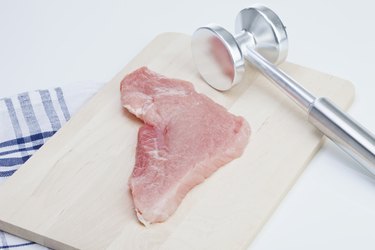
Cooking chicken on a griddle is a great way to add lean protein to your meals — especially if you use the breast, which is lower in fat and calories than other cuts. However, be careful about accidentally adding too much fat by leaving the skin on or using too much cooking oil.
Prepare Your Chicken Breast
Video of the Day
There are two easy ways to prep your chicken breast before you put it on the griddle. The first is pounding: Seal the breast into a large zip-close plastic bag, or wrap it securely in plastic wrap to protect against splattering of raw juices; press out as much air as possible; then go to town with the flat side of a meat mallet until the breast has flattened into a thin, even sheet.
Video of the Day
This accomplishes two things: Tendering the thin sheet of meat, and ensuring that it'll cook more quickly and evenly than a whole chicken breast which is, let's face it, a fairly awkward and uneven shape. As a bonus, if you wanted to cook uniform chicken tenders on the electric griddle, all you have to do is slice that sheet of chicken into long pieces.
You can also marinate the chicken for two or more hours beforehand to tenderize it and introduce exciting flavors, like this fresh mango marinade. And of course, going straight from food packaging to griddle is an option, too. Add flavor by rubbing the chicken with seasonings of your choice — anywhere from sesame seeds to this recipe for spicy turmeric chicken.
Once you're ready to get your griddle on, preheat the griddle over medium heat, add a quick spritz or wipe of cooking oil if it's not already a non-stick surface, then add the chicken.
A whole, unflattened chicken breast will typically need to be cooked for at least five minutes per side, but this varies according to the size and thickness of the meat and the griddle you're using. A flattened chicken breast will cook faster, but regardless, the only way to be sure it's done is by inserting a meat thermometer as close as you can get it to the middle of the breast. More on that in a moment.
Chicken and Food Safety
As the Centers for Disease Control and Prevention (CDC) explains, Americans eat more chicken than any other meat — but raw chicken is often contaminated with one or more types of bacteria that can cause foodborne illness. But following a few important food safety practices will help.
Aside from washing your hands before and after you handle chicken, keeping chicken separate from other foods in your supermarket cart and grocery bags and using a separate cutting board — which should all be the case for any meat products — the CDC also advises against washing raw chicken. That's because this could spread the raw chicken juice to other foods, utensils or surfaces in your kitchen.
But perhaps one of the most important things you can do to ensure the safety of chicken breasts cooked on a griddle — or really, any raw meat — is follow the FoodSafety.gov recommendations for minimum internal temperature. For chicken breasts and all other poultry, that means an internal temperature of at least 165 degrees Fahrenheit, measured by a meat thermometer that you've inserted as close as possible to the center of the meat.
Tip
The CDC recommends refrigerating or freezing any leftover chicken within two hours — or one hour, if the temperature outside is higher than 90 F. According to the USDA Food Safety and Inspection Service, those cooked leftovers will keep for three to four days in the refrigerator or up to four months in the freezer.